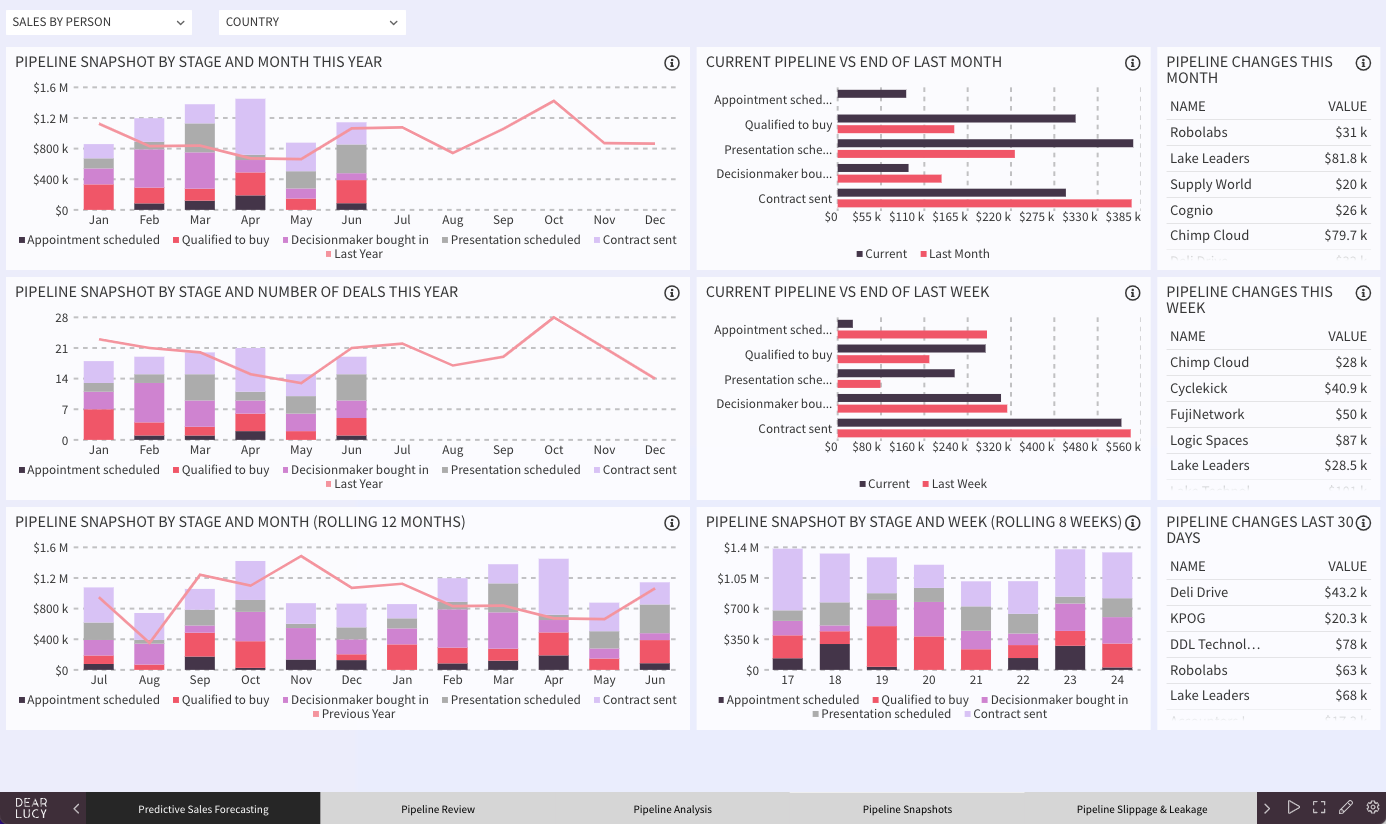For companies striving to excel in B2B sales, having accurate and insightful pipeline analytics is crucial for driving growth and achieving sales targets. For revenue teams using HubSpot CRM, tracking trends and historical data can often be a daunting task. While HubSpot is a powerful tool, many businesses find themselves resorting to manual data exports and spreadsheet snapshots to manage their pipeline analytics effectively. This manual approach not only consumes valuable time but also limits visibility into pipeline behavior, making it challenging to maintain accurate sales forecasts and optimise sales performance.
Say hello to Dear Lucy, the transformative tool for HubSpot CRM users aiming to amplify their pipeline analytics. Dear Lucy provides powerful, predictive sales analytics that seamlessly integrate with HubSpot CRM, delivering comprehensive insights into pipeline growth, changes, and overall pipeline behaviour. These insights are crucial for CROs, sales leaders, and RevOps teams aiming to boost sales performance proactively.
The Challenge with Traditional Pipeline Tracking
Tracking sales trends and historical data within HubSpot CRM can be cumbersome, often requiring manual intervention to extract meaningful insights. Companies frequently export data to spreadsheets to create snapshots, a process that can be error-prone and time-consuming. This traditional method limits visibility into pipeline dynamics, hindering the ability to track sales performance accurately, focus on key metrics, and forecast with precision.
Pipeline Analytics Templates for HubSpot
Dear Lucy transforms the way you analyze your sales pipeline by offering a suite of powerful analytics tools directly integrated into your HubSpot CRM. Here's four ready-made templates to revolutionize your pipeline management:
Pipeline Review
New Deals Added to Pipeline: Easily track all new deals entering your pipeline, ensuring no opportunity goes unnoticed.
Pipeline Snapshots: Explore snapshots to see the evolution of your pipeline over time.
Committed Deals Closing: Monitor deals that are committed to closing within a specific period, providing a clear view of imminent revenue.
Pipeline Value per Person: Assess the pipeline value attributed to each sales rep, facilitating performance evaluations and resource allocation.
Weighted Pipeline Value: Calculate weighted pipeline values to account for deal probability, offering a more accurate forecast.
Pipeline Review template for HubSpot CRM
Pipeline Analysis
Sales Stage Conversion Funnel: Visualize the conversion rates between different sales stages, identifying bottlenecks and optimizing the sales process.
Pipeline Waterfall Analysis: Analyze the flow of deals through the pipeline, from creation to closure, to understand pipeline dynamics.
Deal Length: Track the average time deals spend in the pipeline to identify areas for process improvement.
Deal Win Rate: Measure the success rate of closed deals versus total deals to gauge overall sales effectiveness.
Sales Funnel Leakage: Detect where deals are dropping out of the funnel to implement strategies that reduce leakage.
Pipeline Analysis template for HubSpot CRM
Pipeline Snapshots
Monthly and Weekly Pipeline Snapshots by Stage: Regular snapshots by stage help monitor pipeline changes and health over different periods.
Pipeline Changes: Keep track of how the pipeline evolves, identifying trends and making informed decisions.
Pipeline Snapshots template for HubSpot CRM
Pipeline Slippage and Leakage
Funnel Leakages: Identify stages where deals are most likely to leak out of the pipeline.
Deal Slippage: Monitor deals that are pushed back or delayed, impacting revenue forecasts.
Average Time in Stage: Analyze the time deals spend in each stage to streamline the sales process.
Deal Movements: Track the movement of deals between stages, ensuring no opportunity is left unattended.
Static Deals: Identify deals that remain static for too long, allowing for timely intervention.
Opportunity Values for Upcoming Months: Project future revenue based on current pipeline data, aiding in strategic planning.
Pipeline Slippage and Leakage template for HubSpot CRM
By setting pipeline goals for key metrics at both personal and team levels, you can drive more focused sales efforts and achieve greater growth. Dear Lucy’s predictive analytics not only provide deep insights but also empower your sales teams to take proactive steps towards improving their performance.
Seamless Integration with HubSpot
One of the standout features of Dear Lucy is its seamless integration with HubSpot CRM. This integration allows you to embed Dear Lucy's analytics directly within your HubSpot dashboard, providing a unified view of all your sales data. With an intuitive user interface and powerful visualizations, you can easily navigate through your pipeline metrics and make data-driven decisions that enhance sales outcomes.
Take Charge of Your Sales Pipeline Today
For CROs, CSOs, sales team leaders, sales reps and revenue operations teams in B2B businesses, the value of precise and actionable pipeline analytics cannot be overstated. Dear Lucy's predictive sales analytics solution for HubSpot CRM users addresses the common challenges of manual data handling and limited visibility, offering a comprehensive suite of tools to optimize pipeline management. With powerful, ready-made templates for pipeline analytics, Dear Lucy equips you with the insights needed to drive sales performance and achieve your revenue goals. Embrace the power of predictive analytics with Dear Lucy and unlock the full potential of your sales pipeline.
Interested?
Dear Lucy offers predictive sales analytics across sales solutions like Salesforce, Microsoft, HubSpot and Pipedrive. Book a session with our expert to learn more!























